The yen-to-dollar exchange rate briefly reached its post-war record high of 75.95 on August 19, 2011 in the New York foreign exchange market and has since hovered in a range between 75 to 77. Also, due to Greece's debt crisis, the yen-to-euro exchange rate is at its highest level in some 10 years since the introduction of the euro, with the value fluctuating between 100 and 108, keeping the Japanese economy in a tough situation. As currency hedging against the euro is difficult to conduct, the market is anticipating downward revisions of the performances of companies with high percentage of export to Europe.
What do nominal and real AMU Deviation Indicators indicate?
For Japan, the yen exchange rates to the Asian currencies are as important as those to the dollar and euro. Is the yen also appreciating to the Asian currencies as well as to the major currencies? The trend in the yen exchange rates to the Asian currencies can be assessed by referring to the AMU Deviation Indicators which measure the degree of deviation from the exchange rates during the benchmark period (2000-2001) for the Asian Monetary Unit (AMU) comprised of 13 Asian currencies. Graph 1 exhibits the movements of the nominal AMU Deviation Indicators, which show that of the yen rapidly appreciating in and after the end of 2008 following the global financial crisis caused by the collapse of Lehman Brothers and is part of the strongest group of currencies (yen, Chinese yuan, Singapore dollar, and Thai baht) within the AMU. In 2010, as the Chinese yuan indicator depreciated to around zero (the average value for the Asian currencies), the values of the yen, Singapore dollar, and Thai baht indicators were all around 10 (indicating that the values were 10% above the average value of the Asian currencies). From the time the yen renewed its record high in August 2011, the AMU Deviation Indicator value for the yen alone has continued to appreciate and reached 13 in October 2011, indicating its appreciation relative to the other Asian currencies.
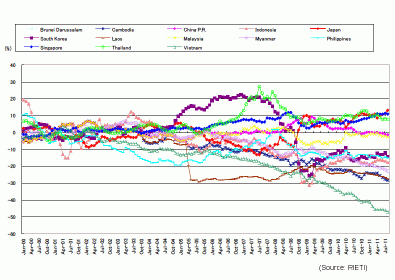
[ Click to enlarge ]
On the other hand, when compared with real effective exchange rates reflecting the adjustment for inflation differentials, it is often pointed out that the current yen exchange rate level, even against the dollar, is not very high. Japan has been in deflation for the past dozen years or so while prices in emerging Asian markets including China have risen, contributing to significant inflationary gaps between Japan and other Asian countries. As indicated by Graph 2, which shows the changes in the Consumption Price Indices (CPI) for the major Asian countries, the CPI for Japan has been flat or somewhat decreasing since January 2008, whereas those for China, Korea, and Singapore have increased by approximately 10% each and those for Indonesia and the Philippines by almost 20% each.
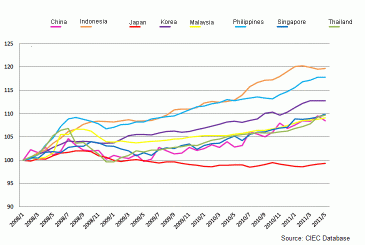
[ Click to enlarge ]
These price factors show a natural consequence of the pressure toward purchasing power parity--the nominal rates of the currencies of countries with high inflation rates depreciate while that of Japan, a country in deflation, appreciates. Graph 3, which displays the real AMU Deviation Indicators adjusted for nominal terms with the inflation differentials of the Asian countries, indicates that the yen, the strongest in nominal terms, is still the weakest among the 13 Asian currencies in real terms. This indicates how significant the cumulative value of Japan's deflation has been.
It has been stated that real exchange rates, which are calculated based on prices, are only theoretical and that the effects of exchange rates on the actual economy should be measured in nominal terms because short-term corporate earnings are calculated based on nominal exchange rates. Nevertheless, when the performances of companies that are forced to implement overseas transfers are examined from a long-term perspective, it has been shown that exchange rates in real terms also demand attention. For example, companies exporting to countries with significant differentials in the AMU Deviation Indicators in real terms can easily pass on the fluctuations in the exchange rates to their sales prices, corresponding to price increases. On the other hand, companies entering economies with high real AMU Deviation Indicators should take into account upward risks for prices and labor costs. Instead of having production centers in those countries, they should consider strategies such as exporting from production bases in neighboring Asian countries.
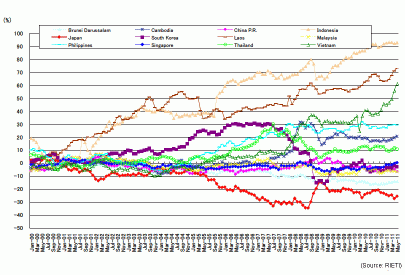
[ Click to enlarge ]
Graph 4 shows the changes in export volume in China, Japan, and Korea in response to the effect of the yen appreciation after the global financial crisis caused by the collapse of Lehman Brothers on exports from these countries. Essentially, the decrease in Japan's export volume immediately after the global financial crisis was the largest. (Year-over-year changes of external trade volume in the first quarter of 2009 were: -19.7%, -40.52%, and -25.6% for China, Japan, and Korea, respectively.) Subsequently, despite initially trailing Korea's recovery, Japan's export volume recovered to the pre-financial crisis level by the fourth quarter of 2010. Total export volume from Japan did not decrease as drastically as the appreciation of the yen to the Chinese yuan and the Korean won in nominal terms.
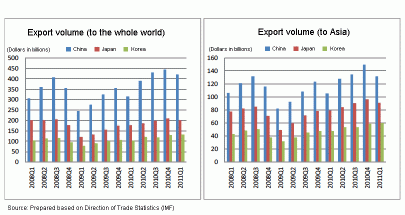
[ Click to enlarge ]
Yen effective exchange rate by industry
The effect of the yen appreciation in 2011 on Japanese exporting companies is often measured in the fiercely competitive areas of transportation equipment, electrical products, and machinery against their Korean rivals as the Korean won depreciated to 15.32 won per yen at the end of September 2011 (the won depreciated by 12% from the same month in the previous year). As such, we will review effective exchange rates by industry released by RIETI (Graph 5), noting that examining the yen's competitiveness by industry is a novel approach. RIETI-released effective exchange rates by industry are the weighted average of the nominal effective exchange rates (100 = January 3, 2000) in relation to the trade volume with "major exporting partners"--each of which constitutes at least 1% of the total export volume in each industry. The differences in the levels of yen appreciation between industries can be compared and examined by referring to these rates. For example, according to the data for 2008 and after, the yen appreciated most significantly in the metal and metal products areas, with differences of as much as five points or more at certain times compared with the precision instruments area. Graph 6 shows the latest movements and indicates that the yen appreciated the most in transportation equipment among the eight industries in 2011. Such data could be reflected in the formulation of policies and can determine which industries should be prioritized in emergency measures against a rising yen.
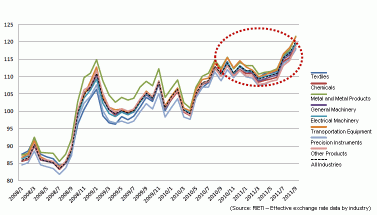
[ Click to enlarge ]
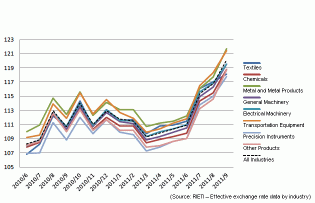
[ Click to enlarge ]
What policies are desirable now?
These facts from above could lead to the following policy proposal:
First, focusing on fluctuations in the exchange rates in the Asian region, the yen is the strongest in nominal terms but is the weakest in real terms, reflecting deflation in Japan. Therefore, while the yen is still strong in nominal terms, we should transfer production centers to the Asian region and conduct M&A activities, thus establishing a system of importing parts and semi-finished products from the production bases in the Asian region to Japan in response to future yen appreciation. Utilizing the ASEAN Free Trade Area (FTA) system, a new strategy in which Japanese companies concentrate their production and export in the ASEAN region is being developed. Subsequently, we should further promote the FTA initiative in order to export from our overseas production centers to consumer countries including Japan and help create an environment in which Japanese companies can more flexibly transfer their production bases within and outside of Japan.
Second, while the overseas transfer of production bases is inevitable, we should keep the planning and development bases in Japan and enhance such functions as global production strategy formulation and multi-currency exchange risks reduction.
Third, in the cases of exports to countries facing inflation, the fluctuations in exchange rates can be easily passed on to local sales prices. We should therefore transform our production structure with the aim of enhancing exports to the Asian region instead of Europe and the United States where long-term economic slowdown is expected.
Fourth, the cumulative effects of deflation in Japan are increasing and leading to appreciation of the yen in nominal terms. Hence, in real exchange rate terms, the yen is not "historically high." Rather, it should be recognized that the yen is actually weak. As a result, we should not simply jump to and rely on subsidies as a "measure against a rising yen and end up piling on the fiscal deficit."
Fifth, as indicated by the effective exchange rates by industry, we should take emergency measures against the rising yen to support transportation equipment-related companies that are severely affected by yen appreciation in effective terms and implement deregulation for helping maintain their competitiveness.



